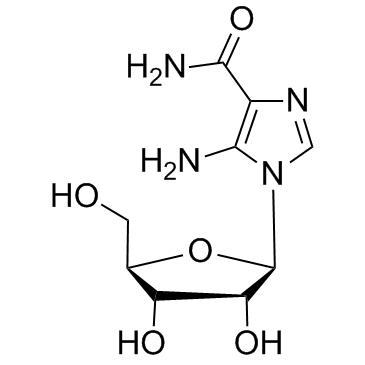All AbMole products are for research use only, cannot be used for human consumption.

AICAR is an adenosine analog and activator of AMPK that regulates glucose and lipid metabolism and inhibits the production of pro-inflammatory cytokines and iNOS. In addition, AICAR is an inhibitor of autophagy, YAP and mitophagy. HepG2 cells are treated with various concentrations of AICAR (0.1-1.0 mM) for 12, 24, and 48 h, respectively. The expression level of IR-β significantly decreases with 0.25, 0.5, and 1.0 mM of AICAR at 48 h to 50%, 53%, and 46% of the control, respectively.
Fourteen-week-old male, lean (L; 31.3 g body wt) wild-type andob/ob (O; 59.6 g body wt) mice are injected with the AMP-activated kinase (AMPK) activator AICAR (A) at 0.5 mg/g per day or saline control (C) for 14 days. At 24 h after the last injection (including a 12-h fast), all mice are killed, and the plantar flexor complex muscle (gastrocnemius, soleus, and plantaris) is excised for analysis. Muscle mass is lower in OC (159±12 mg) than LC, LA, and OA (176±10, 178±9, and 166±16 mg, respectively) mice, independent of a body weight change. The kidney weight is significantly higher in the untreated group when compared with both the exercise and AICAR (0.5 mg/g body wt) groups.

BMC Pulm Med. 2024 May 8;24(1):224.
Simvastatin attenuates silica-induced pulmonary inflammation and fibrosis in rats via the AMPK-NOX pathway
AICAR purchased from AbMole

Front Oncol. 2022 Jul 28;12:968547.
Comprehensive analysis of the glutathione S-transferase Mu (GSTM) gene family in ovarian cancer identifies prognostic and expression significance
AICAR purchased from AbMole

Research Square. 2022 May.
Perfluorooctane sulfonic acid induces liver lipid accumulation through AMPK/ACC signaling
AICAR purchased from AbMole
| Cell Experiment | |
|---|---|
| Cell lines | K562 cell lines |
| Preparation method | Acadesine is added to K562 cell lines or primary cells (103 CD34+ cells/mL) growing in semisolid methyl cellulose medium. MethoCult H4100 or H4236 are used for cell lines and primary CD34+ cells respectively. Colonies are detected after 10 days of culture by adding 1 mg/mL of 3-(4,5-dimethylthiazol-2-yl)-2,5-diphenyltetrazolium bromide (MTT) reagent and are scored by Image J quantification software. |
| Concentrations | 2.5 mM |
| Incubation time | 10 days |
| Animal Experiment | |
|---|---|
| Animal models | mouse xenograft model of K562 cells |
| Formulation | 0.9% NaCl |
| Dosages | 50 mg/kg |
| Administration | Injected intraperitoneally |
| Molecular Weight | 258.23 |
| Formula | C9H14N4O5 |
| CAS Number | 2627-69-2 |
| Solubility (25°C) | DMSO ≥ 50 mg/mL Water 20 mg/mL |
| Storage |
Powder -20°C 3 years ; 4°C 2 years In solvent -80°C 6 months ; -20°C 1 month |
| Related AMPK Products |
|---|
| Aldometanib
Aldometanib (LXY-05-029) is an orally active aldolase inhibitor. |
| SAMS
SAMS peptide is a specific substrate for the AMP-activated protein kinase (AMPK). |
| Marein
Marein has the neuroprotective effect due to a reduction of damage to mitochondria function and activation of the AMPK signal pathway. |
| Malvidin-3-O-arabinoside chloride
Malvidin-3-O-arabinoside chloride ameliorates ethyl carbamate-induced oxidative damage by stimulating AMPK-mediated autophagy. |
| AMPK activator 12
AMPK activator 12 is a potent AMPK activator and GDF15 inducer. |
All AbMole products are for research use only, cannot be used for human consumption or veterinary use. We do not provide products or services to individuals. Please comply with the intended use and do not use AbMole products for any other purpose.


Products are for research use only. Not for human use. We do not sell to patients.
© Copyright 2010-2024 AbMole BioScience. All Rights Reserved.
